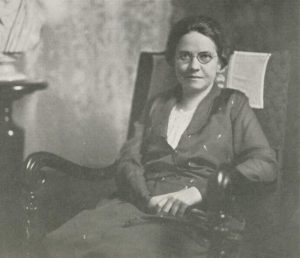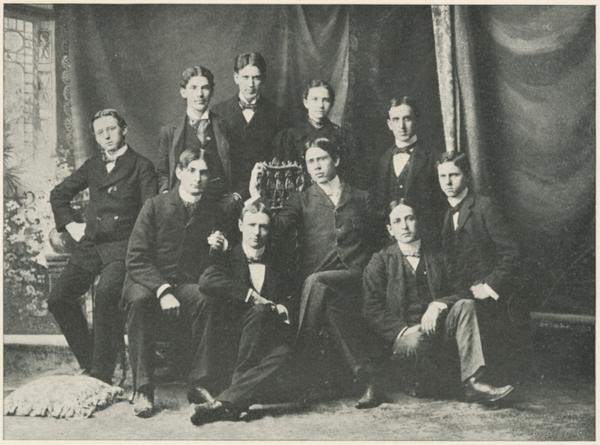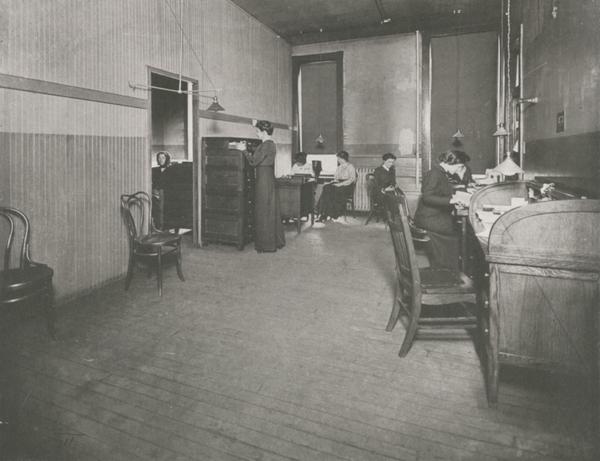
Photo info ...
Credit: Indiana UniversityView Source
(Oct. 24, 1874-June 4, 1942). Edna Gertrude Henry was born to Charles Lewis and Eva N. Henry in Pendleton, Indiana, and grew up in Anderson, Indiana. Her father was a successful practicing attorney and Indiana state senator. In 1897, he built an electric railway track between Anderson and Alexandria, Indiana, and dubbed the system an “interurban line,” the first regional electric railway in the country. The invention brought wealth and prominence to the family. The Henry family convened “church and charitable-minded people” to form a charity organization society, known as Associated Charities. Such organizations established during the last decades of the 19th century, for which the Charity Organization Society Of Indianapolis served as a model, emphasized a scientific approach to charity that involved investigation, registration, and supervision of applicants for poor relief. Edna Henry was the Anderson agency’s first secretary.

The family moved to Indianapolis in 1904, where Charles Henry founded Indianapolis’ Union Traction Company (See ). Edna Henry graduated from prominent Indianapolis suffragist Girls’ Classical School in Indianapolis, then earned a B.A. degree from Indiana University (IU) Bloomington in 1897. Following college graduation, she worked in the Social Service Department (See ). Henry also became a sought-after guest speaker on child welfare and social (friendly) visiting, a late-19th -century approach to social welfare formulated in charity organization societies that called for visits to the homes of the poor to determine what assistance to give based on a family’s circumstances. Henry held leadership positions in three influential Indianapolis social welfare agencies: the Children’s Aid Association (CAA), Mothers’ Aid Society (MAS), and Charity Organization (COS) of Indianapolis. She began training COS volunteers in 1907.
In 1911, Indiana University established the Social Service Department (today the IU School of Social Work), housed with the and the , and appointed Henry as the first director (See ). Henry’s active participation in social welfare agencies had prepared her well, and she dedicated the rest of her life to her career. The Social Service Department pursued three missions: teaching, prevention, and research. The department recorded extensive demographic patient data and built a network of social service agencies to serve its patients. To increase awareness, provide oversight, and raise funds for the school, Henry created an advisory committee of prominent women.

Henry earned her M.A. in economics and social science (1914) and Ph.D. in sociology (1917) from Indiana University while building, staffing, and operating her department. She published her doctoral dissertation, The Theory and Practice of Medical Social Work, in 1924 and attained associate professor rank. Henry shaped the field of medical social work as both a clinical and a humanitarian endeavor. Henry taught that social workers could facilitate recovery from illness through patient education and connection to resources.
In addition to directing the Social Service Department, Henry supervised women who provided reconstruction aid for the rehabilitation of wounded service members during and served as president of the American Association of Hospital Social Workers from 1918 to 1920. The Indianapolis Community Fund (today ) in 1924 awarded Henry honorary fund membership for her “outstanding and unselfish service for the public welfare.” In 1925, she received honorary membership in the American Association of Hospital Social Workers.
Henry suffered an undiagnosed medical event in March 1918 at the age of 44. She resigned as Social Service Department director in 1921 but taught classes in her home until 1926 while confined to a wheelchair. Edna Henry died at the family home, 1414 North Broadway, Indianapolis.

Help improve this entry
Contribute information, offer corrections, suggest images.
You can also recommend new entries related to this topic.